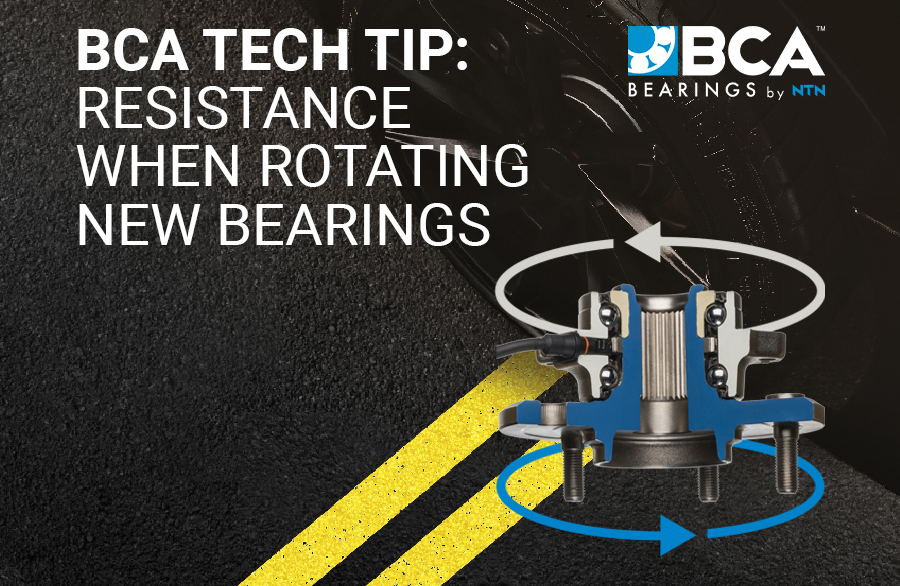Tech Tips
Resistance When Rotating New Bearings
TECH ISSUE:
Wheel bearings feel rough or hard to rotate when new out of the box or freshly installed. It is common to field inquiries from technicians and DIYers about feeling resistance when rotating a new part.
AFFECTED APPLICATIONS:
Gen 1, Gen 2 and Gen 3 Wheel Bearings and Hub Assemblies*
EXPLANATION:
It is always a good practice to visually inspect a new wheel hub assembly/wheel bearing, check the wheel speed sensor wiring and connectors, and to rotate the bearing by hand before installation.
During this initial inspection, it is normal to feel resistance or grittiness as the bearing first rotates. This resistance is not an indication of a defective bearing, but rather the result of tight manufacturing tolerances and the premium grease and seals that BCA uses in our bearings.
 The premium grease used in BCA’s bearings contains performance enhancing additives, which are crystalline in structure, and can cause a rough feeling and rotational resistance when the bearing is new. The structure of the grease is important as it serves multiple critical purposes inside the bearing.
The premium grease used in BCA’s bearings contains performance enhancing additives, which are crystalline in structure, and can cause a rough feeling and rotational resistance when the bearing is new. The structure of the grease is important as it serves multiple critical purposes inside the bearing.
The primary role of the bearing grease is to reduce friction between bearing components and help dissipate heat. The grease also serves to help bearings endure different loads prior to and during operation, and functions as a stabilizing agent for bearing components including the rolling elements, cage, and races. Lubrication is one of the most important factors impacting the operation and longevity of bearings, which is why using a premium grease is of utmost importance for BCA.
Bearing grease also helps protect the rolling elements and raceways during transportation of vehicles or replacement parts. Vehicles and replacement parts spend months on cargo ships, railcars, and transport trucks, prior to being sold, which subjects the wheel bearings to repeated impacts and intense vibrations as they support the stationary weight of a vehicle.
Without proper lubrication, this can cause premature wear spots and shorten the life of the bearings. Since the OE wheel bearings need to stand up to these forces, so too do BCA’s OE quality bearings for the aftermarket, which is why we use premium grease.
The crystalline structure of the grease will begin to breakdown into finer elements within minutes of driving a vehicle, so the rough initial rotation will be smoothed out after a brief test drive.
 Another component that can cause rotational resistance are the premium seals used in BCA’s bearings. Along with the grease, the seals are the unsung heroes of the wheel end. Seals keep the grease in and contaminants out. Some wheel bearings are designed with double or triple lip seals, which introduce multiple contact areas and can cause some initial resistance. Once the bearing is in operation, this resistance will be reduced, and the bearing will turn more freely.
Another component that can cause rotational resistance are the premium seals used in BCA’s bearings. Along with the grease, the seals are the unsung heroes of the wheel end. Seals keep the grease in and contaminants out. Some wheel bearings are designed with double or triple lip seals, which introduce multiple contact areas and can cause some initial resistance. Once the bearing is in operation, this resistance will be reduced, and the bearing will turn more freely.
Finally, many bearings depend on the proper axle nut torque to set the bearing preload. Improperly torquing the fasteners will result in incorrect preload, which can make the bearings feel harder to rotate. This will also cause premature failure of the wheel bearings, so it is important to always follow the installation torque specifications. Some Gen 3 wheel hub assemblies come with their preload set from the factory, so it is normal for these to feel tight out of the box for all the reasons listed above.
*Learn the Difference Between Gen 1, 2 & 3 Wheel Bearings in this BCA HUB Video.
